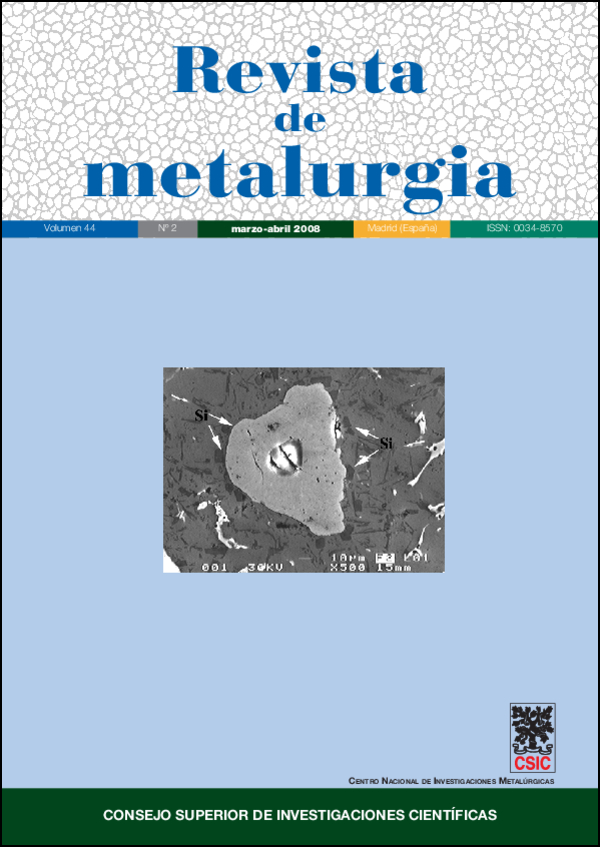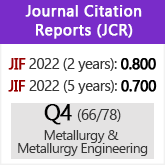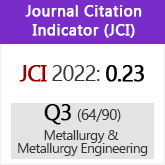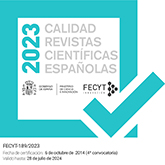Hydrogen damage of a welded API 5L X52 steel
DOI:
https://doi.org/10.3989/revmetalm.2008.v44.i2.99Keywords:
API 5L X52 steel, electrical resistance welding, Hydrogen damage, Hydrogen permeation, BlisteringAbstract
The main objective of the present investigation was to study the susceptibility to hydrogen damage on a type API 5L X52 steel welded by electrical resistance. Several techniques, such as hydrogen permeation and cathodic charging were used. The metallic material was characterized using SEM and TEM. The base metal microstructure was very similar to that one corresponding to the welded area. This microstructure was mainly comprised by ferrite and perlite, differing only in the grain size. Therefore, the susceptibility to hydrogen damage was similar in both cases. It is worth mentioning that the welded area has very small dimensions. Indeed, the fusion zone is only 5 mm wide while the heat affected zone is 1 mm wide. The hydrogen damage observed was mainly in the form of blisters, which were associated to the presence of aluminum rich inclusions. Also, it was noticed partial inclusion dissolution and some matrix attack adjacent to the inclusions.
Downloads
References
[1] H. Duarte, D. See, B. Popov Y R. White, J. Electrochem. Soc. 144 (1997) 2.313-2.317.
[2] H. Baethmann, M. Graef, B. Hoh Y R. Poepperling, Corrosion 203 (1984) 202-230.
[3] L. Coudreuse Y J. Charles, Corros. Sci. 27 (1987) 1.169-1.181.
[4] R. Réquiz, N. Vera, Y S. Camero, Rev. Metal. Madrid 40 (2004) 30-38.
[5] J. A. Carreño, I. Uribe Y J.C. Carrillo, Rev. Metal. Madrid Vol. Ext. (2003) 182-187.
[6] E. Giraldo Y C. Chaves, Departamento de Ingeniería mecánica, Facultad de Minas, Universidad Nacional de Colombia, Medellín, 2002 pp. 59-64.
[7] M.F. De Romero, Z. Duque, O. T. De Rincón, O. Pérez E I. Araujo, Rev. Metal. Madrid Vol. Ext. (2003) 213-218.
[8] Y. Yoshino, Corrosion 39 (1983) 435-443.
[9] J. C. Charbonnier, H. Margot-Marette, F. Moussy, D. Bridoux Y C. Perdrix, Corrosion 293 (1987) 1-15.
[10] M. F. J. Galis Y G. C. Guntz, Corrosion 195 (1988) 1-17.
[11] D. Rydre Y T. Grundy, The American Society for Metals (1982) 272-274.
[12] T. Kaneko, Y. Okada Y A. Ikeda, Corrosion 292 (1987) 1-9.
[13] M. I. Luppo Y J. Ovejero-García, Corros. Sci. 32-10 (1991) 1.125-1.136.
[14] W. C. Luu Y J. K. Wu, Corros. Sci. 38-2 (1996) 239-245.
[15] G. P. Echaniz, T. E. Pérez, C. Pampillo, R. C. Newman, R. P. M. Procter Y G.W. Lorimer, Corrosion 50 (1997) 1-19.
[16] F. Iacoviello, J. Galland Y M. Habashi, Corros. Sci. 40-8 (1998) 1.281-1.293.
[17] B. G. Pound, Electrochemical techniques to study Hydrogen Ingress in Metals, Eds. O’M Bockris et al., Plenum Press, New York, 1993, pp. 63-133.
[18] Turnbull, M. Saenz De Santa María Y N. D. Thomas, Corros. Sci. 29 (1989) 89-104. doi:10.1016/0010-938X(89)90082-6
[19] J. Vera, R. Case Y A. Castro, Corrosion 97(1997) paper 47. (ASTM G148-97): Standard practice for evaluation of hydrogen uptake, permeation and transport in materials by an electrochemical technique (1997)1-9.
[20] J. Flis, T. Zzkroczymski, V. Kleshnyal, T. Kobiela Y R. Dus, Electrochim. Acta 44 (1999) 3.989-3.997.
[21] M. Louthan, The effect of hydrogen on metals. Process Industries Corrosion, NACE, USA, 1975 pp. 126-133.
[22] S. Camero, A. L. Rivas, R. Réquiz Y H. D’armas, Proc.16th Int. Corrosion Cong. Beijing, China, 2005, pp. 10-17.
[23] M. Stratmann, Encycl.Electrochem. Corros. Oxide Flms, 4 (2003) 108-145.
[24] G. Ananta, Mater Sci. 26 (2003) 435-439.
[25] A. Ikeda Y M. Kowaya, H2S Corrosion in oil and gas production: a compilation of classic papers. NACE (1987) 205-212.
[26]C. Turn, Jr., B. E. Wilde Y C. A. Troianos, Corrosion 39 (1983) 384-370.
[27] M. Garet, A. Brass Y F. Gutierres, Corros. Sci. 40 (1998) 1.073-1.086.
[28] Ikeda, Y. Morita, F. Terasaki Y M. Takeyama, 2nd. Int. Cong. Hydrogen in Metals, Paris, 1977, pp. 4-7.
[29] M. Iino. Metall. Trans. 9A (1978) 1.581-1.590.
[30] I. Maroef, D. L. Olson, M. Eberhart Y G. R. Edwards, Int. Mater. Rev. 47 (2002) 191-223. doi:10.1179/095066002225006548
[31] B. E. Wilde, C. D. Kim and E. H. Phelps, Corrosion 36 (1980) 625-632.
Downloads
Published
How to Cite
Issue
Section
License
Copyright (c) 2008 Consejo Superior de Investigaciones Científicas (CSIC)

This work is licensed under a Creative Commons Attribution 4.0 International License.
© CSIC. Manuscripts published in both the printed and online versions of this Journal are the property of Consejo Superior de Investigaciones Científicas, and quoting this source is a requirement for any partial or full reproduction.All contents of this electronic edition, except where otherwise noted, are distributed under a “Creative Commons Attribution 4.0 International” (CC BY 4.0) License. You may read here the basic information and the legal text of the license. The indication of the CC BY 4.0 License must be expressly stated in this way when necessary.
Self-archiving in repositories, personal webpages or similar, of any version other than the published by the Editor, is not allowed.


















